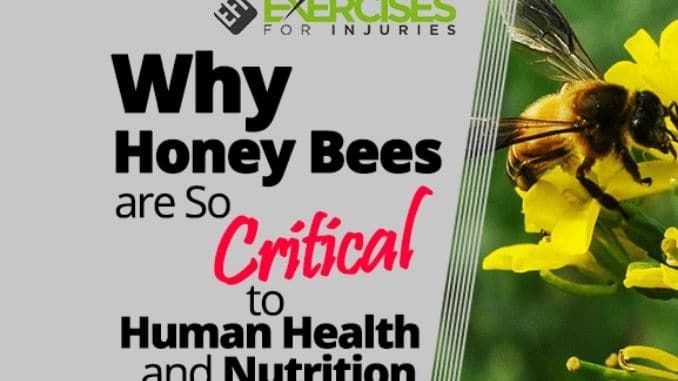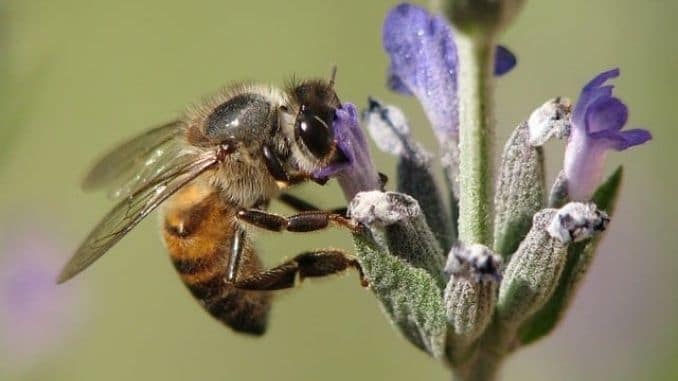
August 19 is both the National Honey Bee Day in the United States and the World Honey Bee Day — a day set aside to recognize the importance of honey bees and the important contribution bees make to our lives.
This special day began back in 2009 when a small group of beekeepers obtained a formal proclamation from the United States Department of Agriculture (USDA). Now, every third day in August is National Honey Bee Day. In 2017, that day falls on August 19.
Why all the buzz about bees? It’s not just about the honey, although that’s a sweet enough reason to think about how we can keep these little insects happy and healthy. But there’s more to this day than meets the eye.
We dug into the issue to find out just what’s going on with our bee populations, why you should care and how bee products benefit our health every day.
Why Are Honey Bees Important?
The importance of Honey Bees cannot be overstated. According to the USDA, honeybees are responsible for pollinating 80 percent of flowering plants and more than 100 crops grown commercially in North America. They are the reason that 75 percent of our fruits, nuts and vegetables grow as they should. One little bee is capable of visiting as many as 50,000 blueberry flowers in its lifetime and pollinating enough to produce more than 6,000 ripe blueberries.
Without bees, we would not only have trouble growing some of the main staples of our diet, but other foods could also be threatened indirectly. Bees pollinate alfalfa, for example, which is one of the main foods used to grow cows. Without it, both the beef and dairy industries would struggle.
The honeybee pollinates crops by stopping at flowers to collect water and nectar. It uses these for food and takes some back to the hive to make other products like honey. While it’s eating, its body rubs against the part of the flower that contains pollen.
Female bees collect this pollen to feed their larvae, but as they move from flower to flower, some of it rubs off. The flower then uses the new pollen to start the process of fertilization. It can then produce the seeds, fruits or vegetables that it normally produces. The bee is a critical part of the plant’s life cycle and many plants depend entirely on bees for reproduction.
The Vital Role of Bees in Human Nutrition: Nurturing Nutrient-Rich Crops and Crop Diversity
The importance of Honey Bees cannot be overstated. According to a 2011 study, some of our most important fruits and vegetables — those that provide some of the highest levels of vitamins and minerals important in the human diet — depend heavily on bees and other pollinating animals. Nutrients like vitamins A, C and E, and much of our calcium, fluoride, and iron come from these foods that depend on bees to grow. So, too, do disease fighters like antioxidants and carotenoids.
“The yield increase attributable to animal-dependent pollination of these crops is significant,” researchers wrote, “and could have a potentially drastic effect on human nutrition if jeopardized.”
Indeed, without these nutrients, human health would suffer. Some of the foods that would no longer be available if all the bees died would include blueberries, watermelons, cucumbers, cantaloupes, broccoli, asparagus, cherries, apples, cranberries, pumpkins and almonds. Other crops produce higher yields when pollinated by bees — these include strawberries, soybeans, pepper, okra, lima beans, grapes and eggplants.
Why Are People Worried About Bee Populations?
Unfortunately, bee populations have experienced significant declines around the world in the last decade or so. The honeybee, in particular, has suffered from massive losses and scientists still aren’t sure why.
The importance of honey bees is truly remarkable. According to the Nature Conservancy, the number of honeybee colonies numbered more than 4 million in the 1970s and have since dropped by almost half to about 2.5 million. Between April 2016 and April 2017, beekeepers across the United States reported a 33 percent loss in their honeybee colonies. This represented the 11th consecutive year of losses that started in 2006.
The Environmental Protection Agency (EPA) calls it “colony collapse disorder (CCD),” a phenomenon in which the majority of worker bees in a colony disappear, leaving the queen, plenty of food and some nurse bees behind. Beekeepers first noticed it during the winter of 2006-07, when many reported frighteningly high losses of 30 to 90 percent of their hives.
What was especially puzzling was that the beekeepers couldn’t figure out why the bees were disappearing. There weren’t any dead bees found around the colonies, and there seemed to be plenty of food in storage. Where did the bees go?
The strange losses continued to happen year after year, with beekeepers losing more than 40 percent of their colonies between 2014 and 2015. Fortunately, the losses seem to be waning since 2010, but they’re still occurring, averaging about 30 percent per year.
Meanwhile, other factors are threatening bee health as well:
- Parasites and pests
- Pathogens (disease)
- Poor nutrition
- Exposure to pesticides
- Changes to habitats
What’s Causing the Bees to Die?
The importance of honey bees. For a long while, scientists have focused mostly on pesticides, as some of them can cause significant harm to a bee colony. Agents applied to crops can kill a bee outright if it comes into contact with the pesticide while foraging in the field. If it’s exposed to a smaller amount that doesn’t kill it. It can still transport that smaller amount back to the colony, as contaminated pollen or nectar, which can then gradually erode the health of the bees that live there.
A 2017 study reported that pesticides can mess up a bee’s navigational powers, so that it can no longer find its way back to the colony and that it can also impair the ability of the bee to fly. Researchers tested thiamethoxam, which is used on common crops like corn, soybeans and cotton, on honey bees and found that within just one hour of low exposure, the bees were not able to fly as long, fast or far.
Honey Bee Survival: A Multifaceted Battle for Flight and Food Security
“Honey bee survival depends on its ability to fly,” said lead researcher Simone Tosi, “because that’s the only way they can collect food. Their flight ability is also crucial to guarantee crop and wild plant pollination.”
Other studies have shown that pesticides can cause significant damage to a bee colony, but more recent research has revealed that it’s more complicated than that.
The varroa mite, which is a pest of honey bees, has recently been identified as a major threat to many colonies. New and emerging diseases like Israeli Acute Paralysis virus and the gut parasite “Nosema” are also killing many bees.
The EPA states that a combination of all factors, including pesticides, parasites, diseases, changes to habitat and more, are threatening bee populations. A number of organizations are working to help reverse the trend, with continuing studies, surveys and additional research. Meanwhile, many farmers are renting beehives from commercial beekeepers to keep their crops going strong.
What You Can Do to Help
To help save the honeybees, you can add native plants to your gardens, reduce your use of herbicides and pesticides in your backyard and buy local honey and other healthy bee products. You can also support your local beekeepers and take part in National Honey Bee Day. See the HoneyLove website for your packet of bumper stickers and other materials that you can use to spread awareness.
The importance of honey bees can also support initiatives that protect honeybees, such as those that seek to limit the most dangerous pesticides like neonicotinoids. The ones that act on the bee’s nervous system mess up its navigational ability and spread the word to your family and friends. The Honey Bee Conservancy has some great videos you can post on social media.
As for those healthy bee products? Here’s a quick summary of those that will benefit your life today.
Raw Honey
Called the “nectar of the Gods” by the ancient Greeks, raw honey is not only tasty, but it’s loaded with nutrients like vitamins, minerals and antioxidants and is a natural antibacterial and antifungal. That’s why you can leave it on your shelf or in your pantry for ages, and it won’t spoil. Studies have shown that it can help heal wounds like ulcers and pressure sores and, at the same time, it also works well as a skin moisturizer and as a way to soothe coughs.
Royal Jelly
This is the white, gel-like substance bees secrete to feed their larvae. It’s a good source of vitamin B, fatty acids, minerals and proteins. Researchers are still studying the benefits of this product, but we have some evidence so far that it may support healthy memory, improve symptoms of menopause, support healthy bones and perhaps help reduce high cholesterol.
Bee Pollen
When bees are visiting flower after flower, some of the pollen they gather is deposited back on the flowers for reproductive purposes, but some of the pollen is taken back to colony to feed the young. This pollen contains nutrients like vitamin B, amino acids and protein and acts as an antifungal, antimicrobial, antiviral and anti-inflammatory. Scientists are still researching this one too, but we have some evidence that it may help lower high cholesterol, reduce the risk of blood clots and protect against heart disease. It may also help reduce systemic inflammation. Do be careful with bee pollen supplements as they could cause a serious allergic reaction, particularly if you’re allergic to the flowers, grass and other plants where the pollen came from. Check with your doctor first.
Beeswax
This is a natural wax produced by some honey bees and then used to form cells or combs for honey storage and larval protection in the hive. Bees actually must eat honey first before they can make beeswax — about 6 to 8 pounds of honey to product one pound of wax. We humans use it in a number of ways: to make lip balm and skin moisturizer, to make “healthier” candles that don’t produce toxic smoke, to make homemade soap last longer, in various lubricants, to wax skis and bowstrings and much more.
Propolis
Bees make this substance to “glue together” the materials in their hives. They mix beeswax with other secretions and resins to produce a sticky product that coats their hives. This product is rich in antioxidants that can help fight disease and has been found in studies to help heal wounds and cold sores, fight infections, support healthy teeth and gums and perhaps even to help fight cancer. One study also showed that it helped to get rid of warts.
If you want to know what foods will help you shape up and shed inches while providing natural cure to illnesses, then check out the Best Foods That Rapidly Slim & Heal in 7 Days program, here!





